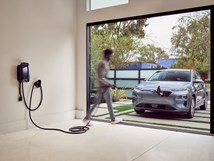Byton: Electric, Level 3 and Conceptual—For Now
Unveiled at CES 2018, the Byton electric vehicle will have Level 3 autonomous capabilities at launch in 2019 and then will be able to have Level 4 integrated about a year later.
#hybrid #electronics #interior
The only way they’re going to be achieving economies of scale, explains Dr. Daniel Kirchert, president and co-founder of Byton, is through having a single platform upon which three vehicles can be built: a midsize-crossover, a sedan and a seven-passenger vehicle. So the team of Byton engineers, a small cadre, Kirchert says, working in a manner that is more typical of a start-up than a conventional OEM, set to work at designing and engineering the crossover in Munich a couple years ago, and they’re working at acquiring the paperwork—both in the way of government permits and additional funding—to break ground on a plant in Nanjing, China, that Kirchert anticipates will be up and operational by the latter part of 2019.
The initial capacity will be 100,000 units annually, then after what he calls “phase one” is operational, they’ll be expanding to achieve a capacity of 300,000 units.
Perhaps this is burying the lede, but the crossover that Kirchert and his colleague Dr. Carsten Breitfeld, Byton CEO and co-founder, unveiled at CES 2018 is an electric vehicle that will have Level 3 autonomous capabilities at launch in 2019 and then will be able to have Level 4 integrated about a year later. While there will be the seemingly now-obligatory over-the-air updates, Level 4 will be achieved not only through software, but hardware additions. One of the ways they’ve designed the vehicle is so that there need not be much in the way of reengineering the vehicle to accommodate the higher level of autonomous technology. (“Without touching the platform,” Kirchert says.)
Initially, Kirchert acknowledges, going to Level 4 will be “quite expensive,” but goes on to explain that as they anticipate that the Level 4 crossover will probably be used in vehicle sharing applications. That approach, rather than individual ownership, he suggests, makes the business case for the additional sensors and other equipment more reasonable.
In terms of the vehicle itself, the numbers are, by and large, competitive. For example, the vehicle will be offered in two ways. One is a rear-drive setup, which includes a 200-kW motor and a 71-kWh battery pack. That configuration will have an estimated range (they are using the European NEDC protocol for testing) of 248.5 miles. Then there is a four-wheel drive model that has two motors combined to provide 350 kW; they will be powered by a 95-kWh battery pack that provides a range of 322 miles. The battery can be recharged to 80 percent capacity within 30 minutes via fast charging.
The crossover is 191 inches long with a 116-inch wheelbase. It is 65 inches high and is 76 inches wide. It seats four. All of that is fairly standard. But what isn’t are two things. For one, the starting price of the vehicle is $45,000. While it isn’t clear exactly what technology is going to be offered as standard equipment, the prototype includes such things as gesture control, cameras in place of side-view mirrors and cameras in the B-pillars that recognize the driver and passenger so as to unlock the doors. Which means that that price point is rather, well, aggressive.
And for another remarkable number: the instrument panel is a 49 x 9.8-inch screen that literally stretches the length of the IP. It provides information not only about the vehicle performance (e.g., speed), but also infotainment, navigation and the state of health of the driver and front seat passenger (e.g., pulse). When the vehicle is Level 4 capable and in the self-driving mode, the front seats can be swiveled 12 degrees toward one another so that the people in the front seats as well as those in the rear can watch entertainment on the massive screen (this will be predicated on things like legislation, given that watching Amazon Prime—yes, in the U.S. there will be Amazon Alexa integration—is not something that drivers are legally able to do).
According to Breitfeld and Kirchert, when they decided to develop Byton, they immediately identified China as the place where the company needed to be established. Among the reasons cited are the fast growth in the automotive market there, as well as government support for startups.
It is worth noting that the two men have solid resumes in the industry. Kirchert has been in China for a number of years. Prior to Byton, he was managing director of Infiniti China and president of Dongfeng Infiniti Motor Co., and before that, he was the senior vice president of sales and marketing at BMW Brilliance. Breitfeld was previously a vice president and head of the BMW i8 plug-in hybrid project. His team helped launch the i8 in 38 months. The Byton timeline is perhaps more aggressive.
Speaking of the pace that the small company (there are approximately 500 employees right now) has been taking for the past couple years, Kirchert jokes that there has been a consequence: “I have a few more gray hairs now.”
RELATED CONTENT
-
The Genovation GXE: >220 mph and Street Legal
A 2019 Corvette Grand Sport has a starting price on the order of $66,950. The Genovation GXE, which is predicated on the Corvette Grand Sport, will set you back some $750,000.
-
All About the 2018 Honda Accord
The common wisdom seems to be that midsize cars have pretty much had it in the U.S. new car market.
-
2017 Mazda MX-5 Club RF
The Mazda slogan “Driving Matters” pretty much sums up the 2017 MX-5 Miata Club RF.













